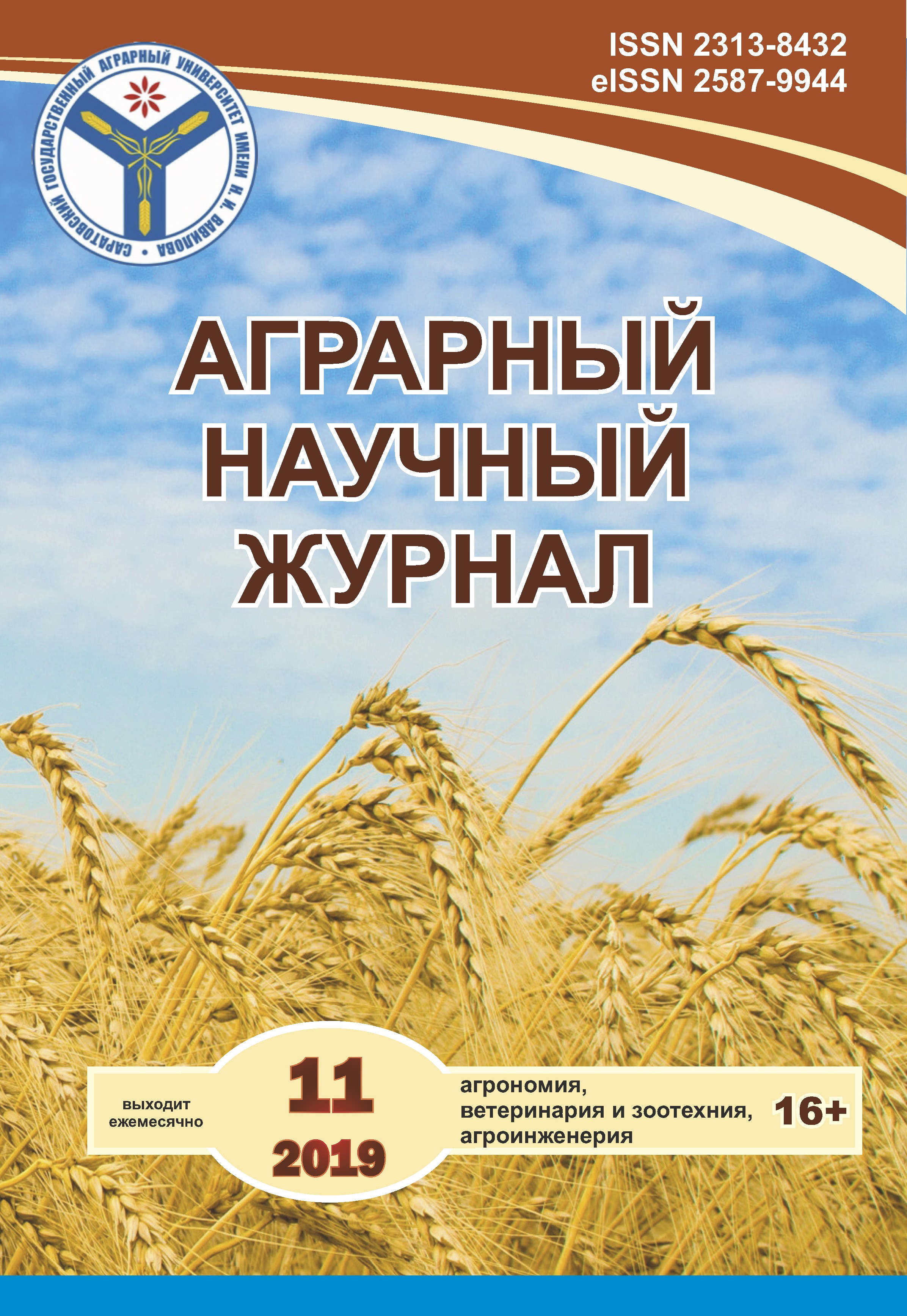Productivity of spring grain crops depending on the method of basic treatment of the soil in the grain-cultivated crop rotation
DOI:
https://doi.org/10.28983/asj.y2019i11pp31-35Keywords:
spring wheat, barley, dumped, subsurface, minimal, combined tillage, density, water permeability, soil moisture contentAbstract
Three-year scientific observations showed that in the arid conditions of the Saratov Trans-Volga region on dark chestnut soils in a grain-cultivated crop rotation before sowing spring wheat and barley, the highest soil density was after the minimum cultivation - 1.25 g/cm3. Plowing to a depth of 23–25 cm contributed to a decrease in the density of addition in the arable layer compared to subsurface cultivation by 9%, and compared to the minimal one – by 13%. Minimal treatment with a disc harrow BDM 7 Ch 3 to a depth of 10–12 cm reduced the permeability of dark chestnut soil by 38% in the first hour of observation and by 51% after the fourth hour compared to plowing. Before sowing spring early-ripening crops, the maximum moisture accumulation in the soil in a layer of 50–100 and 0–100 cm was after deep non-dump cultivation (13.9 and 15.7%), which was 1.5 and 0.5% more than the control values. During the tillering phase of spring wheat and barley, the maximum moisture content of the upper soil layer was noted in the control and after combined treatment (15.7–15.8%). The combined main processing of dark chestnut soils of the Saratov Trans-Volga region provided an increase in the yield of spring early crops by 0.8–3.0%. Minimization of soil cultivation reduced the productivity of barley and spring wheat by 23.3–28.2%, subsurface cultivation by 8.3–9.4% compared with the control. The coefficient of variation in the yield of spring wheat and barley by the main processing methods in 2017 was average and amounted to 11.3–15.2%, in 2018 it was insignificant - 6.3–6.9%, and in 2019 it was significant - 23, 5–40.9%.
Downloads
References
2. Бородычёв В.В. Пимонов К.B., Михайличенко Е.Н. Агрохимическая оценка применения минеральных удобрений и биопрепаратов при возделывании нута в Ростовской области // Плодородие. – 2018. – № 1 (100). – С. 34–37.
3. Влияние минеральных удобрений и биопрепаратов на урожайность нута на черноземе южном/ Е.Н. Михайличенко [и др.] // Аграрный научный журнал. – 2018. – № 4. – С. 16–21.
4. Динамика плотностипочвы чернозема южного при минимализации основной обработки / А.П.Солодовников [и др.] // Земледелие. – 2015. – № 1. – С. 5–7.
5. Доспехов Б.А. Методика полевого опыта. М: Агропромиздат,1985. – 351 с..
6. Зависимость плотности почвы как основного показателя плодородия от других агрофизических факторов / К.Е. Денисов [и др.] // Аграрный научный журнал. – 2016. – № 9 – С. 27–30.
7. Основные проблемы современного земледелия при освоении ресурсосберегающих технологий: учеб. пособие / С.Н. Бурахта [и др.]; ФГОУ ВПО «Саратовский ГАУ». – Саратов, 2010. – 100 с.
8. Перспективные приемы обработки почвы в сухостепной зоне Поволжья /Ф.П. Четвериков [и др.]; ФГБОУ ВО Саратовский ГАУ. – Саратов, 2017 . – 200 с.
9. Пимонов К.И., Козлов А.В. Вайда красильная и нут – предшественники озимой пшеницы на черноземе обыкновенном // Земледелие. – 2012. – № 1. – С. 26.
10. Прямой посев полевых культур в Ставропольском крае / Г.Р. Дорожко [и др.] // Земледелие. – 2013. – № 8. – С. 20–23.
11. Солодовников А.П., Абросимов А.С. Влияние различных приемов основной обработки черноземов южных на продуктивность чечевицы в условиях Правобережья // Вестник Саратовского госагроуниверситета им. Н.И. Вавилова. – 2013. – № 4. – С. 39–44.
12. Солодовников А.П., Денисов Е.П., Тарбаев Ю.А. Отзывчивость ярового ячменя на технологии сберегающего земледелия в условиях Саратовского Правобережья // Известия Оренбургского государственного аграрного университета.– 2015. – № 2 (52) – С. 50–51.
13. Сохранение плодородия почвы и повышение продуктивности ячменя после фитомелиорации /А.П. Солодовников [и др.] // Аграрный научный журнал. – 2017. – № 2. – С. 29–34.
14. Шеин Е.П., Гончаров В.М. Агрофизика. – Ростов н/Д: Феникс, 2006. – 397 с.
15. Энергосберегающие технологии обработки почвы при возделывании ярового ячменя на южных черноземах Правобережья /К.Е. Денисов [и др.] // Вестник Саратовского госагроуниверситета им. Н.И. Вавилова. – 2012. – № 4. – С. 9–12.
16. Solodovnikov A.P. et al. (2018). Minimizing tillage to preserve the agro-chemical and water-physical properties of southern black soil after vegetative reclamation // International Journal of Mechanical Engineering and Technology (IJMET), Vol. 9, I. 12, December: 1166–1172.








